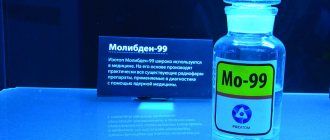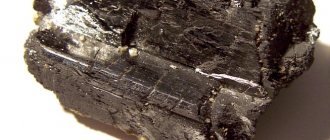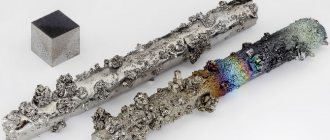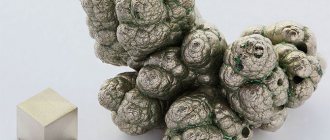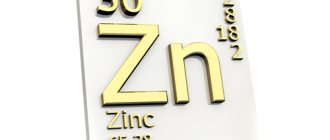Being in nature
The occurrence of free molybdenum in nature has not been recorded. But two dozen minerals based on it have been identified. The most notable: molybdenite, molybdite, wulfenite.
Molybdenite from Australia
In the earth's crust the element is distributed evenly. Also found in rivers, seas, fossils of organic origin (plant ash, coal, oil). However, the total mass content of the metal is hundredths of a percent.
World reserves of molybdenum are estimated at 11.5 million tons.
Australia and both Americas (USA, Canada, Mexico, Chile) have large deposits. In Europe – Russia and Norway.
Mining is carried out using closed or open-pit methods.
Metal discovered in space. Its concentrations are off the charts in systems with a central star - a red (super) giant and a neutron star inside it.
Production
Molybdenum deposits and its production by country
| A country | Deposits (thousand tons) | 2001 | 2002 | 2003 | 2004 | 2005 | 2006 | 2007 | 2014 |
| USA | 2700 | 37,6 | 32,3 | 29,9 | 41,5 | 58,0 | 59,8 | 59,4 | 68,2 |
| China | 3000 | 28,2 | 30,33 | 32,22 | 29,0 | 40,0 | 43,94 | 46,0 | 103,0 |
| Chile | 1905 | 33,5 | 29,5 | 33,4 | 41,48 | 47,75 | 43,28 | 41,1 | 48,8 |
| Peru | 850 | 8,35 | 8,32 | 9,63 | 9,6 | 17,32 | 17,21 | 17,25 | 17,0 |
| Canada | 95 | 8,56 | 7,95 | 8,89 | 5,7 | 7,91 | 7,27 | 8,0 | 9,7 |
| Russia | 360 | 3,93 | 4,29 | 3,57 | 3,11 | 3,84 | 3,94 | 4,16 | 4,8 |
| Mexico | 135 | 5,52 | 3,43 | 3,52 | 3,7 | 4,25 | 2,52 | 4,0 | 14,4 |
| Armenia | 635 | 3,4 | 3,6 | 3,5 | 3,0 | 2,75 | 3,0 | 3,0 | 7,1 |
| Iran | 120 | 2,6 | 2,4 | 2,4 | 1,5 | 2,0 | 2,0 | 2,5 | 4,0 |
| Mongolia | 294 | 1,42 | 1,59 | 1,6 | 1,7 | 1,19 | 1,2 | 1,5 | 2,0 |
| Uzbekistan | 203 | 0,58 | 0,5 | 0,5 | 0,5 | 0,57 | 0,6 | 0,5 | 0,5 |
| Bulgaria | 10 | 0,4 | 0,4 | 0,2 | 0,2 | 0,2 | 0,4 | 0,4 | ? |
| Kazakhstan | 130 | 0,09 | 0,05 | 0,05 | 0,23 | 0,23 | 0,25 | 0,4 | — |
| Kyrgyzstan | 100 | 0,25 | 0,25 | 0,25 | 0,25 | 0,25 | 0,25 | 0,25 | ? |
| Others | 1002 | — | — | — | — | — | — | — | — |
| Total | 11539 | 134,4 | 124,91 | 129,63 | 141,47 | 186,26 | 185,66 | 188,71 |
Genetic groups and industrial types of deposits
1. Contact-metasomatic (skarns).
2. Hydrothermal.
A. High temperature (greisen). B. Medium temperature. A. quartz-molybdenite. b. quartz-sphalerite-galena-molybdenite. V. quartz-chalcopyrite-molybdenite (porphyry copper ores). pitchblende-molybdenite.
How it was opened
The history of the discovery of the element begins in the second half of the 18th century.
Shiny silver-white metal
It was written by three scientists:
- Swedish chemist Karl Scheele obtained the oxide.
- The Frenchman Pierre Guelm isolated the metal. But its purity was symbolic.
- The production of metal almost without “dirt” is the merit of the patriarch of European chemists, Swede Jens Berzelius. This happened at the dawn of the 19th century.
A century later, the era of the heyday of metal began.
Molybdenum steel was smelted in tons for the needs of the armies that fought on the fronts of the First World War.
Later they developed a technology for producing metal using powder metallurgy.
The name of the element is of ancient Greek origin: μόλυβδος means “lead”.
It was molybdenite that caused the confusion. It was obtained first, but the shine of the substance copied lead.
For the same reason, until the 18th century, molybdenum was called graphite.
Types of scrap
Molybdenum-containing waste is standardized by GOST 1639-93. According to it, molybdenum scrap is divided into:
- Pure molybdenum in the form of pieces of pipes, rods, rods, slabs, plates, etc. Metal content not lower than 99%. On the rare earth metals market in Moscow, this type of scrap is the most profitable in price.
- Lump waste with 2% contamination and weighing at least 20 g.
- Remains of electrodes, parts of electric vacuum furnaces, X-ray tubes, electric heater elements with a metal content of up to 95%.
- The name is similar to the previous paragraph, but the amount of molybdenum is 98%.
- Wire and shavings. Molybdenum 90%.
- Powdered molybdenum with a content of foreign impurities of no more than 5%.
- Pastes, seeds and other compounds based on molybdenum. Pure metal 75%.
This division is conditional. More detailed information can be obtained directly from scrap metal collection points in Moscow or another region of Russia.
Molybdenum (lat. molybdaenum) is a chemical element with atomic number 42 and atomic mass 95.94. Denoted by the symbol Mo. It is a malleable transition metal that is gray with a steely tint when free and turns gray-black when dispersed. About 20 molybdenum minerals have been discovered, but it is not found in free form.
The name of the metal comes from the Greek word “molybdos”, which means “lead”. This name was chosen because the mineral molybdenum has a characteristic luster very similar to that of lead.
In 1778, the Swedish chemist K. Scheele first obtained the mineral molybdenite by calcining molybdic acid. Another Swedish chemist P. Gjelm obtained molybdenum in the form of an impure metal in 1781, and only in 1817 J. Berzelius managed to isolate this element in its pure form.
Physico-chemical characteristics
Molybdenum has many advantages:
- Elasticity, almost zero expansion when heated, resistance to heat and corrosion.
- Electrical conductivity is higher than iron.
- Only tungsten has higher mechanical strength. But under pressure, molybdenum is processed more easily.
- The main chemical property of the metal is its resistance to almost all alkaline solutions and aggressive acids, regardless of their concentration and temperature.
Disadvantages of metal: fragility when welding, insignificant ductility.
| Properties of the atom | |
| Name, symbol, number | Molybdenum / Molybdaenum (Mo), 42 |
| Atomic mass (molar mass) | 95.96(2) a. e.m. (g/mol) |
| Electronic configuration | [Kr] 4d5 5s1 |
| Atomic radius | 139 pm |
| Chemical properties | |
| Covalent radius | 130 pm |
| Ion radius | (+6e) 62 (+4e) 70 pm |
| Electronegativity | 2.16 (Pauling scale) |
| Electrode potential | −0,2 |
| Oxidation states | 6, 5, 4, 3, 2 |
| Ionization energy (first electron) | 684.8 (7.10) kJ/mol (eV) |
| Thermodynamic properties of a simple substance | |
| Density (at normal conditions) | 10.22 g/cm³ |
| Melting temperature | 2623 °C |
| Boiling temperature | 4885K |
| Ud. heat of fusion | 28 kJ/mol |
| Ud. heat of vaporization | ~590 kJ/mol |
| Molar heat capacity | 23.93 J/(K mol) |
| Molar volume | 9.4 cm³/mol |
| Crystal lattice of a simple substance | |
| Lattice structure | cubic body-centered |
| Lattice parameters | 3.147 Å |
| Debye temperature | 450 K |
The negative characteristics of molybdenum appear only at ultra-low temperatures or incorrect use.
Physical properties
The use of molybdenum depends on its properties and characteristics. The inherent physical properties of molybdenum are given below:
- metal type - high temperature melting;
- molybdenum color – lead;
- molybdenum density - 10.2 g/cm3;
- melting at a temperature of 2615°C;
- boiling at a temperature of - 4700°C;
- thermal conductivity - 143 W/(m K);
- thermal capacity - 0.27 kJ/(kgK);
- energy for melting - 28000 J/mol;
- energy for evaporation - 590000 J/mol;
- linear expansion, coefficient - 6·10-6;
- electrical resistance - 5.70 μOhm cm;
- calculated volume - 9.4 cm3/mol;
- shear force - 122·10·6 Pa;
- hardness - 125 HB;
- magnetic permeability -90·10-6.
This metal is not often subjected to turning, but processing is carried out with a standardized tool.
Grades and alloys
Industry uses molybdenum as a pure metal, with additives and alloys.
The range of brands includes dozens of items. There are several most common ones:
| Brand | Characteristics |
| MCH | Mo – no additives. |
| MChVP | Mo – no additives, melted in vacuum. |
| MRN | Mo – there are no additives, but there are impurities. |
| MK | Mo + additive (alkali silicon). |
| CM | Mo + additive (zirconium or titanium). |
| MV | Molybdenum-tungsten alloy. |
| MR | Molybdenum-rhenium alloy. |
Additions of Mo (less than a percent) to structural steels multiply their toughness, strength, and corrosion resistance.
To increase the hardness of the metal, cobalt-chromium alloys are used.
Alloys “molybdenum + nickel + cobalt + chromium” increase resistance to acids and heat.
Obtaining molybdenum
The raw materials from which metallic molybdenum is produced are molybdenum concentrates. They contain about 50% of this element. They also contain: sulfur ~ 30%, silicon oxide (up to 9%) and about 20% of other impurities.
The concentrate is pre-fired for additional oxidation. The process is carried out in two types of furnaces: multi-hearth or fluidized bed. Firing temperature 570 °C - 600 °C. The result is cinder - MoO3 and impurities.
In the next step, impurities are removed to obtain pure molybdenum oxide. Two methods are used:
- Sublimation at a temperature of 950 °C - 1100 °C.
- Chemical leaching. The essence of the method is that when interacting with ammonia water, impurities of copper and iron are eliminated and molybdenum carbide is obtained, which is crystallized by evaporation or neutralization. Next, the carbide is heated and maintained at temperatures up to 500°C. The output is pure MoO3 oxide, in which the impurity content is only 0.05%.
Molybdenum production is based on the reduction of MoO3. The process is carried out in two stages:
- In a tube furnace at a temperature of 550°C - 700°C, oxygen atoms are separated in a flow of dry hydrogen.
- Then the temperature rises to 900°C - 1000°C and final recovery occurs. The resulting metal is in powder form.
To obtain a monolithic metal, powder is melted or sintered. Melting is used when producing workpieces weighing more than 500 kg. The process is carried out in arc furnaces with a cooled crucible, into which a consumable electrode is supplied from previously sintered rods.
Obtaining molybdenum
Powder sintering is pressing in a hydrogen atmosphere at high pressure (2000-3000 atmospheres) and temperature (1000°C - 1200°C). The resulting bars are subjected to sintering at high temperatures equal to 2200°C - 2400°C. Subsequently, molybdenum is given the required shape through pressure treatment - forging, rolling, broaching.
Ferromolybdenum, which contains up to 60-70% molybdenum and the rest is iron, is widely used in industry. It is obtained by introducing molybdenum additives into steel. The alloy is produced by reducing cinder with iron silicate with the addition of steel filings and ferrous ore.
Where is it used?
The refractoriness, variety and ease of processing of the metal, and other physical and chemical properties have determined the areas of use of products made from it.
Metallurgy
The main consumer of raw materials is metallurgy. Its products from molybdenum are wire, rods, powder, sheet, and rod.
Molybdenum powder
These are blanks for a range of products produced by almost all industries.
Other industries
The lion's share of products made from molybdenum and metal alloys is taken by manufacturers of radio and electric lamps, radio electronics.
There is enough material for other purposes:
- Molds, machine parts for injection molding of alloys.
- Electrovacuum production (X-ray tubes).
- Positive electrode of lithium-based current sources.
- Shells of nuclear reactor parts.
- Heaters for electric furnaces operating in harsh conditions.
- The outer layer of the “nose” segment of the body of supersonic aircraft.
- Electrodes for glass melting.
- Catalysis of chemical reactions.
- Varnishes, paints for porcelain, textiles, furs.
These products are created on the basis of natural compounds and metal alloys.
The newest area of application of molybdenum is space technology.
Assortment: components of rocket (ion, plasma) engines; skin of descent vehicles; heat exchangers. Here, the properties of molybdenum are corrected by alloys with niobium and tantalum.
Pure crystalline Mo is used as a component of mirrors for special purpose lasers.
Microdoses of metal are added to agricultural fertilizers.
Advantages/disadvantages
- Advantages:
- has a high melting point, and therefore heat resistance;
- because the density of this metal (10200 kg/m3) is almost two times less than the density of tungsten (19300 kg/m3), then molybdenum-based alloys have significantly greater specific strength (at temperatures below 1370 °C);
- has a high elastic modulus;
- low temperature coefficient of expansion;
- has good heat resistance;
- small cross section for thermal neutron capture;
- Molybdenum is characterized by high corrosion resistance. This metal is stable in most alkaline solutions, as well as in sulfuric, hydrochloric and hydrofluoric acids at different temperatures and concentrations.
- Flaws:
- has little scale;
- high fragility of welds;
- low plasticity at low temperatures;
- work hardening can be used only up to 700-800 °C; at higher temperatures, softening occurs due to return.
Meaning for humans
The effect of molybdenum on living organisms was studied by the middle of the 20th century.
It turned out that this microelement:
- Regulates the synthesis of amino acids.
- Activates antioxidants, including ascorbic acid.
- It is part of enzymes and the tissue respiration system.
Mo deficiency in the body is signaled by weakened immunity (fatigue, frequent illness).
Molybdenum dust is toxic. Its prolonged inhalation provokes blood diseases and irreversible destruction of the lungs.
Influence of alloying elements on the heat resistance of austenitic steels
In this article we will talk about the effect of some alloying elements on the heat resistance of steels. At the warehouse of Novstal LLC, such steels include rolled grade 20x23n18
Titan influence
In heat-resistant steels and alloys with carbide hardening, titanium introduced in small quantities (0.1-0.3%) improves their long-term strength. When introduced in large quantities into complex alloyed heat-resistant steels with carbon, titanium reduces the hardness and strength characteristics and increases the plastic properties at room and high temperatures. Changes in mechanical properties are due to the fact that titanium binds carbon into stable carbides, which do not take part in the processes of dispersion hardening. Therefore, the process of formation of chromium and vanadium carbides in the presence of titanium at a Ti:C ratio > 5 is greatly weakened and the steel becomes less prone to strengthening due to dispersion hardening. In heat-resistant alloys with intermetallic hardening based on a y-solid solution, titanium is an alloying element that greatly increases the heat-resistant properties due to dispersion hardening processes associated with the formation of a y'-phase of the Ni3 (TiAl) type. The temperature-variable solubility of titanium in y-solid solutions depends on the content of chromium and other alloying elements and determines the kinetics of formation of the y'-phase during aging of an alloy pre-hardened in a solid solution.
Stainless steel markings
In Russia and the CIS countries, an alphanumeric system has been adopted, according to which numbers indicate the content of steel elements, and letters indicate the name of the elements. The designations common to all are the letter designations of alloying elements: H - nickel, X - chromium, K - cobalt, M - molybdenum, B - tungsten, T - titanium, D - copper, G - manganese, C - silicon.
Standard stainless steel, according to GOST 5632-72, is marked with letters and numbers (for example, 08Х18Н10Т). In the United States, there are several systems for naming metals and their alloys. This is due to the presence of several standardization organizations, these include AMS, ASME, ASTM, AWS, SAE, ACJ, ANSI, AJS. It is quite clear that such marking requires additional clarification and knowledge when trading metal, placing orders, etc.
Europe (EN)
Germany (DIN)
USA (AISI)
Japan (JIS)
CIS (GOST)
Of the variety of brands, we use three main ones in our production - AISI 304, AISI 316 and AISI 430.
Modern classification of stainless steel
Stainless steel is a type of alloy steel that is resistant to corrosion due to its chromium content. In the presence of oxygen, chromium oxide is formed, which creates an inert film on the surface of the steel, protecting the entire product from adverse influences.
Not every grade of stainless steel demonstrates the resistance of chromium oxide film to mechanical and chemical damage. Although the film recovers when exposed to oxygen, special grades of stainless steel have been developed for use in aggressive environments.
The first conditional type of division into groups:
- Food
- Heat resistant steel
- Acid resistant steel
The second type of classification is by microstructure:
- Austenitic
- non-magnetic steel with the main components of 15-20% chromium and 5-15% nickel which increases corrosion resistance. It is well suited to heat treatment and welding. It is the austenitic group of steels that is most widely used in industry and in the production of fasteners. - Martensitic steels
are significantly harder than austenitic steels and can be magnetic. They are hardened by quenching and tempering like simple carbon steels, and are used mainly in the manufacture of cutlery, cutting tools and general engineering. More susceptible to corrosion. - Ferritic steels
are much softer than martensitic steels due to their low carbon content. They also have magnetic properties.
